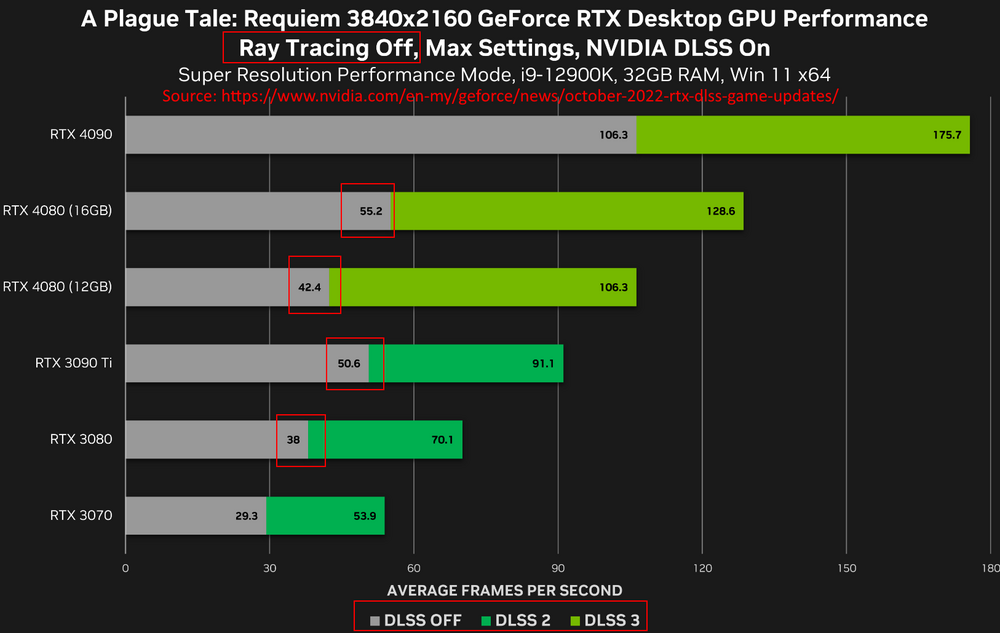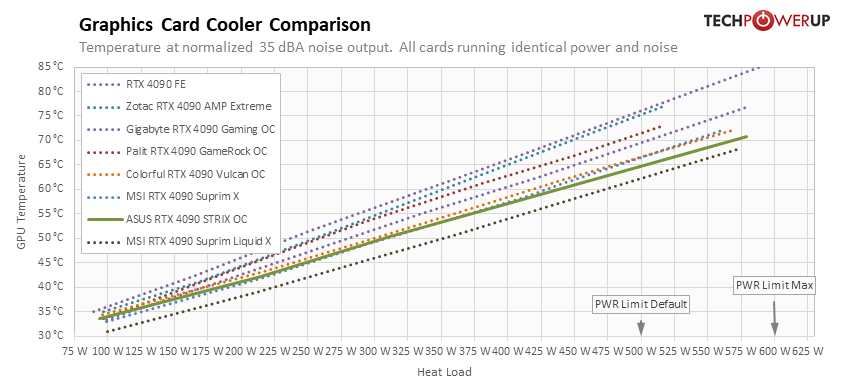-
Posts
2,999 -
Joined
-
Last visited
-
Days Won
151
Content Type
Profiles
Forums
Events
Everything posted by electrosoft
-

*Official Benchmark Thread* - Post it here or it didn't happen :D
electrosoft replied to Mr. Fox's topic in Desktop Hardware
If you needed a large capacity drive AND you already have a loop in place why not? 🙂 Overkill? Probably, but ah well. 🙂 -

*Official Benchmark Thread* - Post it here or it didn't happen :D
electrosoft replied to Mr. Fox's topic in Desktop Hardware
Nice find! That was my top pick out of the gate but would have to be imported. 😞 Steve over at Gamer's Nexus had one brand new sitting on his presentation desk while he was talking about Nvidia in general and the 4080 12GB fiasco. Hopefully he is going to do a full review and teardown: -

*Official Benchmark Thread* - Post it here or it didn't happen :D
electrosoft replied to Mr. Fox's topic in Desktop Hardware
-

*Official Benchmark Thread* - Post it here or it didn't happen :D
electrosoft replied to Mr. Fox's topic in Desktop Hardware
Pulling what? All intervals? Idle? Where does it start to scream? -

*Official Benchmark Thread* - Post it here or it didn't happen :D
electrosoft replied to Mr. Fox's topic in Desktop Hardware
Yep, that makes total sense. Unless AMD comes out with something competitive with the 4090, I expect to not see a TI variant for about a year during a mid cycle refresh. If AMD can bring the high heat, then I wouldn't be shocked to see it in Q1 or Q2 at the latest of 2023. -

*Official Benchmark Thread* - Post it here or it didn't happen :D
electrosoft replied to Mr. Fox's topic in Desktop Hardware
Nvidia was shook the last time around with Ampere vs RDNA2. They brought the heat this time around and left nothing on the table Ada. I was hoping AMD had mastered their chiplet approach to bring effectively 2x the performance as RDNA2 theoretically and really shake Nvidia up even more at least in pure rasterization. If AMD can only shake things up to let's say the 4080 16GB that leaves the 4090 to roam free and Nvidia to keep back the 4090ti for much longer as they have no reason to release it or scale down their expectations for Titan as previously tried and go full fat full FP on a Titan card with the ~18k core dies and enable SLI since there is no competition at the top for them. -
That's just straight up beautiful bro. I've been using the same case for over a year now and lack of room is never an option. Only gripe I have is still I wish it was an inch deeper in the back (giggity) for a touch more wire management room but I'm dealing with 6x PCIe leads for my KPE 3090ti atm. 🙂
- 153 replies
-
- 1
-

-
- build log
- monster desktop
-
(and 3 more)
Tagged with:
-

*Official Benchmark Thread* - Post it here or it didn't happen :D
electrosoft replied to Mr. Fox's topic in Desktop Hardware
I'm pretty sure the cancelled Titan (at this moment) is different than the 4090ti. Still hilarious. 🙂 This was on Videocardz dated the 12th in regards to a 4090ti so it's in the works: https://videocardz.com/newz/according-to-the-rumor-nvidia-is-already-saving-ad102-gpus-for-geforce-rtx-4090-ti -

*Official Benchmark Thread* - Post it here or it didn't happen :D
electrosoft replied to Mr. Fox's topic in Desktop Hardware
Really the only flat out monster upgrade over a 3090 is a 4090 and that is a 1600+ proposition. 4080 12gb is a non starter and the 4080 16GB is a big ball of "meh" to me. The specter of a 4090ti w/ DP 2.0 has me curious too. -

*Official Benchmark Thread* - Post it here or it didn't happen :D
electrosoft replied to Mr. Fox's topic in Desktop Hardware
Bah, minor upgrade.....you won't see a difference at all....wasted money! 🤣 Congrats bro! That uplift is going to rock your world and then some! -

*Official Benchmark Thread* - Post it here or it didn't happen :D
electrosoft replied to Mr. Fox's topic in Desktop Hardware
Yeah the Gigabyte model extends it a bit further than an EVGA/MSI AIO Hybrid and uses a copper plate to cover all the vital hot spots but it isn't as expansive or well done as a true block. The 3090 variant had decent temps. Here is Dawid breaking the 3090ti variant down: -

*Official Benchmark Thread* - Post it here or it didn't happen :D
electrosoft replied to Mr. Fox's topic in Desktop Hardware
Ask and you shall receive (sorta) 🙂 https://videocardz.com/press-release/alphacool-releases-360mm-aio-kit-for-nvidia-geforce-rtx-4090-reference-gpus -

*Official Benchmark Thread* - Post it here or it didn't happen :D
electrosoft replied to Mr. Fox's topic in Desktop Hardware
The idea of spilling 500-600w of heat in my case does not excite me though. 🙂 I won't be doing that song and dance ever again.... At least the FE spits a large chunk of it out but I do remember feeling all that heat radiating from the rear side mem and the fins being very hot on my FE 3090. -

*Official Benchmark Thread* - Post it here or it didn't happen :D
electrosoft replied to Mr. Fox's topic in Desktop Hardware
-

*Official Benchmark Thread* - Post it here or it didn't happen :D
electrosoft replied to Mr. Fox's topic in Desktop Hardware
Definitely going to need either shunt or truly EVGA/Galax class unlocked BIOS to see where it starts to tap out.... -

*Official Benchmark Thread* - Post it here or it didn't happen :D
electrosoft replied to Mr. Fox's topic in Desktop Hardware
LOL....it wouldn't matter if it was or not. You're going to just overcome anything and everything and extract wicked numbers out of it anyhow. We all know this. -

*Official Benchmark Thread* - Post it here or it didn't happen :D
electrosoft replied to Mr. Fox's topic in Desktop Hardware
Congrats! Enjoy your "trash" Zotac. 🙂 -

*Official Benchmark Thread* - Post it here or it didn't happen :D
electrosoft replied to Mr. Fox's topic in Desktop Hardware
I agree. My favorite two models are the Suprim Hybrid and FE. The Gigabyte Hybrid doesn't look too bad either and it is the only Hybrid over here that actually cools the GPU and VRMs with the AIO and has zero fans on the card itself. -

*Official Benchmark Thread* - Post it here or it didn't happen :D
electrosoft replied to Mr. Fox's topic in Desktop Hardware
There is always brand loyalty and aesthetics to consider too. Not everyone wants that FE slab look in their system. -

*Official Benchmark Thread* - Post it here or it didn't happen :D
electrosoft replied to Mr. Fox's topic in Desktop Hardware
I saw this a bit ago and I agree. On the other hand, everyone of my local Microcenters have 4090's in stock but only the trash models (Zotac, MSI low end, etc...). Best Buy and Newegg are sold out but the day is young and those who buy from eBay are going to be kicking themselves when a month from now everything is back in stock plus AMD on the horizon. -

*Official Benchmark Thread* - Post it here or it didn't happen :D
electrosoft replied to Mr. Fox's topic in Desktop Hardware
After the 3090ti FTW3 space heater week before returning it, it just had me double down on Hybrid or potential block. When I had my FE 3090, I ran it in a Corsair 540 with all the panels off for a framed look so I never really got to experience the heat dump into the case nor was it on the level of that FTW3 3090ti. It was already cold outside so I didn't realize the heat dump into the room too. Regardless, if you're into competitive benching, a block is basically the entry point then you have your chiller to really kick it up a notch. For gaming, it is what do you expect? If the game play is all that matters, get a 720p display, turn everything down to low and get a 1060 and run everything. But everyone has their own expectations and desired experience. Back in the day when I was a competitive Quake player, we aimed (no pun intended) to turn everything down as much as possible not only for frame rates but it made everything stand out more starkly for targeting. Eye candy was a distraction. Then turn around and Deus Ex comes out a few years later and I'm overclocking everything with the best video card I can find to pump up details as much as possible and get acceptable frame rates at 1080p and still wanted more. This chasm of expectations still exists to this day for gamers.... .....this is the way. 🙂 -

*Official Benchmark Thread* - Post it here or it didn't happen :D
electrosoft replied to Mr. Fox's topic in Desktop Hardware
Thank you Papu! Still my favorite site linker. (Crocs and all 🤣) -

*Official Benchmark Thread* - Post it here or it didn't happen :D
electrosoft replied to Mr. Fox's topic in Desktop Hardware
Congrats bro! Once you clean up those cables with some Cablemod love, it is going to look even more slick. -

*Official Benchmark Thread* - Post it here or it didn't happen :D
electrosoft replied to Mr. Fox's topic in Desktop Hardware
I'll be curious to see how the hybrid cards fair against all this air cooling. For air cooled cards, Aesthetically, the FE 4090 I like. I do like the Strix design too. It is very Asus like. I'm excited to see some new builds with new GPUs and new motherboards too. I greatly enjoy watching other people's builds and results. -

*Official Benchmark Thread* - Post it here or it didn't happen :D
electrosoft replied to Mr. Fox's topic in Desktop Hardware
So much new hardware this fall......the temptation is real to at least get one of something. I fully expect the power of Intel to compel you and you'll pick up a 13900k 🙂





